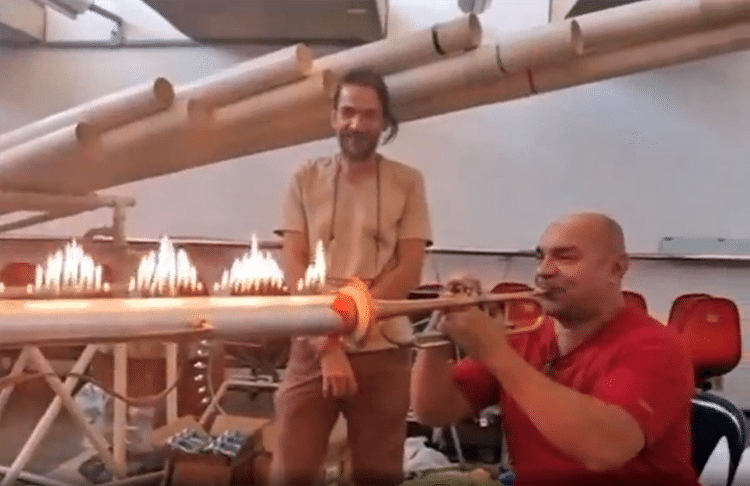
Photo: Screenshot from Reddit
It’s not often we get to “see” sound. Perhaps we occasionally notice the digital waves in a voice recording, but watching sound happen—especially in real life—is a rarity. One classic physics experiment, however, allows us to do just that. Called Rubens Tube, or a standing wave flame tube, it displays the relationship between sound waves and sound pressure. A viral post on Reddit demonstrates what this looks like in practice using a Rubens Tube powered by a trumpet. The mesmerizing result is a spectacular display of scientific principles.
The physics experiment was created by German physicist Heinrich Rubens in 1905. The setup involves a piece of pipe that has holes drilled along its top and is sealed on either end. One end is a propane tank (or other supply of flammable gas) and the other is the source of the sound. The pipe is then lit and a standing flame appears. When a sound is made—in this case, the trumpet plays—the oscillating pressure of the sound waves lets gas escape and shapes the sound curve.
The trumpet player shows how quickly sound waves change, and how the various notes in his tune play a role in manipulating the flame. It’s a reminder that even the smallest things in our world are incredible when you stop to consider the physics of it all.
Scroll down to see the trumpet Rubens Tube video that has gone viral as well as more videos featuring the experiment.
A classic physics experiment called Rubens Tube allows us to “see” sound. This viral trumpet performance demonstrates its principles.
The physics experiment was created by German physicist Heinrich Rubens in 1905. Here’s an explanation of how it works and the setup.
This concept has been used in other musical settings.
The oscillating pressure of the sound waves lets gas escape and shapes the sound curve. It can look quite different depending on the sound being made at any given time.
h/t: [Reddit]
Related Articles:
Teacher Creates Fun Science Experiment to Show Kids the Importance of Hand Washing
Science Experiment Shows How 25,000 Random Dice Neatly Assemble into Perfect Circles
Viral Video of Physics Professor Shows the Lengths He Goes to to Make Science Fun
